|
|
Progress of Advanced Boron Carbide Ceramic Materials Prepared by Precursor Derived Method
WANG Hao, WANG Jin-Long, GOU Yan-Zi
2017 Vol. 32 (8): 785–791
 Abstract
Abstract(
1136 )
 HTML
HTML(
13)
 PDF
PDF(430KB)(
1559
)
Boron carbide (B4C) is a kind of advanced ceramics with excellent properties, which has been widely applied in military, nuclear, aerospace, and other high-tech fields. The fabrication of boron carbide by precursor derived method has been well developed in recent years. Comparing with other preparative approaches, the precursor derived method has a variety of advantages including simple elemental composition, good formability, high ceramic yield, and low energy consumption, which has been widely applied to prepare boron carbide powder, fibers, mesoporous ceramics and ceramic microspheres. In this paper, current development of boron carbide prepared by precursor derived method was reviewed. Synthesis and application of boron carbide precursors were mainly discussed. In addition, the future efforts and application prospects of precursor-derived boron carbide ceramics were also analyzed.
|
|
|
Research Development on Lithium Rich Layered Oxide Cathode Materials
CHEN Yu-Fang, LI Yu-Jie, ZHENG Chun-Man, XIE Kai, CHEN Zhong-Xue
2017 Vol. 32 (8): 792–800
 Abstract
Abstract(
1610 )
 HTML
HTML(
26)
 PDF
PDF(454KB)(
1638
)
Lithium rich layered oxide cathode materials (xLi2MnO3·(1-x)LiMO2(M=NiyMnzCo1-y-z….) are one of the candidate cathode materials for the new generation of lithium ion batteries because of the high theoretical capacity and low cost. In this paper, the structure of the cathode materials and the structure activation and evolution within initial charge-discharge and the cycling process were outlined, the effect of structure evolution on electrochemical evolution of the Li-rich cathode materials were further investigated. And, the current works of ion doping and surface modification on the cathode materials to enhance electrochemical properties were summarized and the development trend of different lithium rich layered oxide cathode materials was described.
|
|
|
Preparation and Property of a Novel Heat-resistant Ceramic Composite Solid-state Electrolyte for Lithium Batteries
LI Cheng-Bin, YUE Hong-Yun, WANG Qiu-Xian, LI Jing-Xian, YANG Shu-Ting
2017 Vol. 32 (8): 801–805
 Abstract
Abstract(
932 )
 HTML
HTML(
11)
 PDF
PDF(441KB)(
1502
)
Poly(ethylene oxide) (PEO) as a kind of promising candidates of polymer electrolyte is widely applied in all solid lithium ion batteries. In this study, a novel ceramic composite solid electrolyte (CLASP) was prepared by dip-coating PEO-LAGP-SN-LiTFSI (PEO-SPE) into Al2O3 nonwoven membrane. And all solid batteries were assembled with CLASP. CLASP showed excellent thermostability even at 170℃ for 2 h. When the ratio of PEO: LAGP: SN: LiTFSI was 3: 1: 1: 1, the conductivities of CLASP reached 3.66×10-5 S/cm at 25℃ and 2.52×10-4 S/cm at 100℃, respectively. The electrochemical window of CLASP was 5.5 V, which had great potential to apply in battery with high voltage cathode material. The cycling performance of all solid batteries with CLASP was greatly improved at 55℃ as well. This new ceramic composite, solid polymer electrolyte, with all these outstanding performance is a promising candidate of all solid electrolytes.
|
|
|
Corrosion Resistance of HVOF-sprayed Nano- and Micon-structured WC-η Coatings against Molten Zinc
YANG Tao, WANG Hai-Bin, SONG Xiao-Yan, LIU Xue-Mei, HOU Chao, WANG Xue-Zheng
2017 Vol. 32 (8): 806–812
 Abstract
Abstract(
579 )
 HTML
HTML(
1)
 PDF
PDF(609KB)(
1084
)
WC-η (i.e. Co6W6C, Co3W3C, etc) composite powder was synthesized by in situ reduction and carbonization reactions using tungsten oxide, cobalt oxide and carbon black as raw materials. Mean particle size of the as-synthesized composite powder is about 155 nm. Thermal spraying powder with a high density and an excellent flowability was prepared using WC-η composite powder by agglomeration and heat-treatment. Cemented carbide coatings were then fabricated by high velocity oxy-fuel (HVOF) spraying technique using nanostructured and commercially available low-carbon WC-12Co thermal spraying powders as feedstock. The results show that equiaxed W2C particles form at certain amount in the nanostructured coating while cracks propagate mainly along grain boundaries and phase interfaces. However, the micron-structured coating still contains W besides W2C, which mainly distribute in outer surface of WC grains. The micron-structured coating has stronger tendency to get transgranular fracture. As a result, the cracks go forward along a relatively straight path. Due to higher density, finer grain size and much larger interface area, the nanostructured coating has simultaneously higher hardness and fracture toughness as compared to the micron-structured coating. After immersion into molten zinc for 200 h, the micron-structured coating suffers from more serious cracking along the directions perpendicular and parallel to the interface between coating and substrate, which causes the large-scale exfoliation of coating material and the corrosion of substrate. In contrast, zinc diffusion is not observed in the nanostructured coating and only a few cracks perpendicular to the coating/substrate interface are locally produced. Moreover, the inner surfaces of the crack are covered with tungsten and cobalt oxides, which inhibit corrosion of the nanostructured coating in molten zinc. Therefore, the nanostructured coating has a promising corrosion resistance against molten zinc.
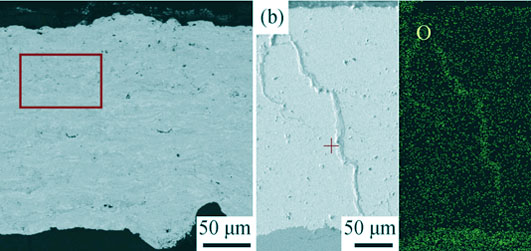
|
|
|
Grain Growth Inhibitor on the WC-Co Cemented Carbide Coating
WANG Xue-Zheng, WANG Hai-Bin, LIU Xue-Mei, YANG Tao, SONG Xiao-Yan
2017 Vol. 32 (8): 813–818
 Abstract
Abstract(
688 )
 HTML
HTML(
2)
 PDF
PDF(526KB)(
955
)
The ultrafine WC-12Co composite powder was synthesized by in situ reduction and carbonization reactions. Using the composite powder with an addition of 1.0wt% grain growth inhibitor (GGI) i.e. VC, Cr3C2 and NbC, as raw materials, the ultrafine-structured cemented carbide coatings were fabricated by the high velocity oxy-fuel (HVOF) spraying method. Prior to thermal spraying, the powders were agglomerated into thermal spray feedstock. The effects of GGI addition on phase constitution, microstructure, hardness, and wear and corrosion properties of the coatings were investigated. The results show that the mean WC particle size of coatings with an addition of 1.0wt% VC or Cr3C2 decreases by about 49% as compared to that without GGI. Moreover, hardness of the coatings is significantly improved and the wear rate decreases by 52%-55%. Addition of 1.0wt% NbC has little effect on WC particle size of the coating but leads to formation of (W, Nb)C compound in the Co binder. Thus the corrosion resistance of the coating containing NbC is significantly enhanced. However, its wear resistance is lower than those with VC or Cr3C2, due to high brittleness of the (W, Nb)C compound.
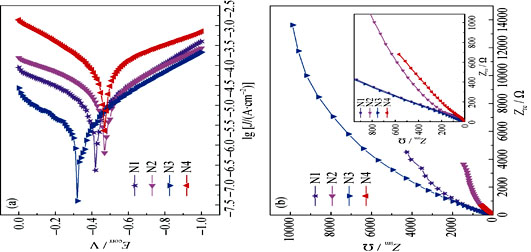
|
|
|
Microstructure Evolution and Mechanism of Al2O3/BaZrO3 Double Ceramics
ZHANG Hao, GAO Peng-Yue, CHEN Guang-Yao, LI Ming-Yang, LU Xiong-Gang, LI Chong-He
2017 Vol. 32 (8): 819–824
 Abstract
Abstract(
504 )
 HTML
HTML(
5)
 PDF
PDF(499KB)(
863
)
The Al2O3/BaZrO3 double ceramics sample with size of 50 mm×25 mm×5 mm was prepared via sintering at 1550℃ by using Al2O3 as back layer (silica sol as binder), fused BaZrO3 as surface ceramics. The phase identification and crystal structure were determined by X-ray diffraction (XRD), while the microstructure and interfacial reaction were carried out by scanning electron microscopy (SEM) coupled with energy dispersive X-ray spectroscope (EDS). SEM-EDS results show that the surface layer is mainly composed of BaZrO3 matrix, with tiny yttria-stabilized zirconia grains (10 μm) uniformly distributed. The interface reaction between Al2O3 and BaZrO3, leads to form a 300 μm thick transition layer. Composed of BaAl2O4 (BaO·Al2O3) and ZrO2. Thus, the microstructure of interface transfers from a simple double ceramic Al2O3/BaZrO3 interface into a complex structure, which is composed of BaZrO3, ZrO2, BaO·Al2O3, and Al2O3. During the reaction, the element Ba of BaZrO3 migrates into the Al2O3 layer and forms BaO·Al2O3, then the residual becomes a strip-shaped ZrO2 layer. The element Al of Al2O3 almost does not diffuse, and the ternary oxides BaO·Al2O3·2SiO2 are formed around EC95(Al2O3+5%SiO2) particles.
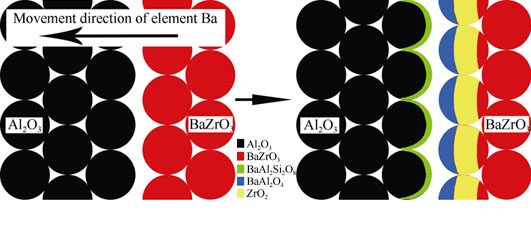
|
|
|
Spark Plasma Sintering of Bioactive Ca2MgSi2O7 Ceramics
WANG Ming-Hui, ZHONG Hong-Bin, FAN Yu-Chi, CHEN Ting
2017 Vol. 32 (8): 825–830
 Abstract
Abstract(
617 )
 HTML
HTML(
4)
 PDF
PDF(515KB)(
968
)
The bio-ceramics based on Ca and Si have wide development prospect in biomedical, which is attributed to their outstanding bioactivity and cytocompatibility. However, how to improve its sinterability is a key problem to be solved. In this study, pure Ca2MgSi2O7 powders were prepared via a co-precipitation method, and then were sintering by spark plasma sintering (SPS) technique. The phase and the morphology of the resulting products were characterized by X-ray diffraction (XRD) and scanning electron microscope (SEM), respectively. The relative density and the bioactivity were also investigated by Archimedean method and simulated body fluid (SBF) soaking method, respectively. Experimental results showed that the Ca2MgSi2O7 ceramics with density of about 99% could be achieved by spark plasma sintering at 1170℃ for 5 min under 70 MPa. After soaking in the simulated body fluid for 3 d, phosphate precipitation was observed on the surface of the ceramics, while bone-like hydroxyapatite was formed until 7 d soaking, indicating that the Ca2MgSi2O7 ceramics prepared by SPS have good bioactivity to induce the sedimentation of bone-like hydroxyapatite.
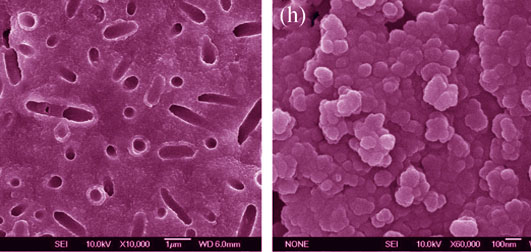
|
|
|
Effect of Citric Acid Concentration on the Properties of Borate Glass Bone Cement
LI Hai-Bin, WANG De-Ping, WU Ying-Ying, YAO Ai-Hua, YE Song
2017 Vol. 32 (8): 831–836
 Abstract
Abstract(
726 )
 HTML
HTML(
11)
 PDF
PDF(476KB)(
1142
)
A novel injectable borate glass bone cement (BGBC) was prepared by using citric acid-β glycerophosphate-chitosan solution as setting solution. The effect of citric acid (H3Cit) concentration (0.1, 0.2 and 0.4 g/mL) on the properties of BGBC was investigated by using vicat apparatus, universal testing machine, XRD, FTIR, and SEM-EDS measurements. The experimental results indicate that H3Cit concentration significantly influences setting time and injectability of BGBC. At the H3Cit concentration of 0.2 g/mL, BGBC obtains the shortest setting time of (16±0.5) min and best injectability, which is almost fully injectable. It compressive strength increases with the increase of H3Cit concentration, with the maximum compressive strength up to (26.7±1.9) MPa. SEM images show that a large amount of nanoparticles are formed in the BGBC. XRD, FTIR and EDS results confirm that these nanoparticles contain borates, phosphates and phosphates. Furthermore, formation of borate crystals in the BGBC is influenced by H3Cit concentration. Immersion experiment of borate glass particles into phosphate buffer with different H3Cit concentrations shows that the degradation of borate glass is accelerated by H3Cit.
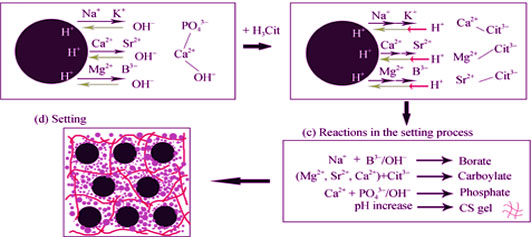
|
|
|
Hydroxyapatite Whisker-reinforced Composite Scaffolds Through 3D Printing for Bone Repair
XIN Chen, QI Xin, ZHU Min, ZHAO Shi-Chang, ZHU Yu-Fang
2017 Vol. 32 (8): 837–844
 Abstract
Abstract(
1151 )
 HTML
HTML(
25)
 PDF
PDF(666KB)(
1264
)
Development of bioactive scaffolds with controllable architecture and high osteogenic capability is essential for bone tissue engineering. In this study, hydroxyapatite whiskers (HAPw) were added into polycaprolactone (PCL) matrix materials to fabricate scaffolds through 3D printing technique. The HAPw could distribute homogeneously in PCL and in alignment with 3D printing directions by adjusting squeeze parameters. The mechanical strength of PCL-HAPw composite scaffolds increased along with the increase of HAPw content. Adding 33wt% of HAPw remarkably enhanced the compressive strength of PCL scaffolds to 3 times, which can also lower the surface contact angles from 100° of PCL to 50° and thus enhance the surface hydrophilicity. In vitro culturing experiments of human bone marrow mesenchymal cells (hBMSCs) demonstrated that the incorporation of HAPw promoted their bioactive and osteogenic properties, including better cytocompatibility, cell adhesion, proliferation, alkaline phosphatase (ALP) activity, and bone-related gene expressions (OCN, RUNX2). Therefore, 3D-printed HAPw-PCL composite scaffolds showed improved mechanical strength and osteogenesis properties compared to pure PCL scaffolds, and suggest promising applications in bone regeneration.
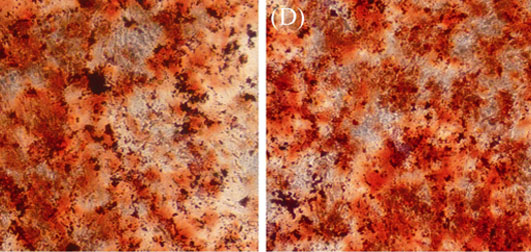
|
|
|
Synthesis of Polydopamine Modified Mesoporous Silica Microspheres for Encapsulation of L-menthol
BAI Jia-Feng, WANG Xi-Qing, CHEN Yi-Chang, DENG Yong-Hui, LI Zhi-Hua, LIU Hong, LIU Shao-Hua
2017 Vol. 32 (8): 845–850
 Abstract
Abstract(
1288 )
 HTML
HTML(
13)
 PDF
PDF(388KB)(
1415
)
Ordered mesoporous silica materials (OMS) possess high specific surface areas, large pore volume, open channel structure, easily tunable surface functionalities, and good biocompatibility. They have great potential for application in various fields, such as drug delivery, enzyme immobilization, and catalysis. In this study, ordered mesoporous silica microspheres with large pore sizes were synthesized via a non-polar solvent assisted co-assembly method in a water- n-hexane biliquid solution. The obtained mesoporous silica microspheres possess large pore size of 6.9 nm and high surface area of 615 m2/g. Through a nanocasting method, L-menthol was successfully loaded into the mesopores. Through an interface polymerization of dopamine, polydopamine (PDA) was deposited on the external surface of the composite microspheres. By monitoring the weight change of the composite microspheres during treatment by hot air flow, the menthol release behavior was evaluated. As a result of the presence of permeable PDA in shell, the composite microspheres were found to release L-menthol in a controllable way, especially at an appropriate temperature of about 50℃. This study provides an important primary guideline for potential applications of mesoporous silica functionalized with PDA in bio-medicine, adsorption and separation, and so on.
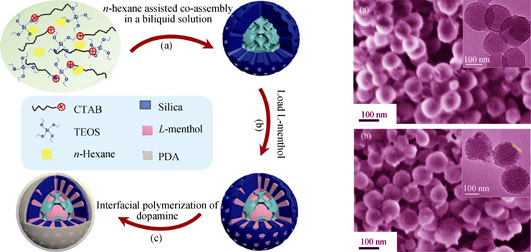
|
|
|
Large-sized La2O3-TiO2-SiO2 Amorphous Oxide Fabricated by Hot Press Sintering
LI Ren-Yi, LI Xiao-Yu, LI Jian-Qiang, ZHAO Jian-Ling, MA Xiao-Guang, HE Gang, LI Jiang-Tao
2017 Vol. 32 (8): 851–856
 Abstract
Abstract(
728 )
 HTML
HTML(
1)
 PDF
PDF(454KB)(
999
)
La2O3-TiO2 amorphous oxide has prospective applications because of its remarkable optical properties. However, due to its poor glass-forming abilities, it is difficult to prepare this material in a traditional way. The containerless solidification method can overcome this shortcoming, but the formed material size is generally restricted to be less than 10 mm. In order to obtain large-sized La2O3-TiO2 amorphous oxide, a small amount of SiO2 was added to the La2O3-TiO2 oxide system to form the amorphous oxide powders by aerodynamic levitation furnace. Subsequently, the high-density La2O3-TiO2-SiO2 materials were fabricated by vacuum hot press sintering. Compositions and microstructure properties were systematically studied by XRD and SEM. The results showed that SiO2 could improve the glass-forming ability of La2O3-TiO2. The raw powders made by aerodynamic levitation furnace were completely non-crystal, while the sintered samples had weak crystallization, which affected fully densification of sintered samples. There was a small amount of porosity in the high-density product made by vacuum hot press sintering. In addition, sintering densification mechanism of the La2O3-TiO2-SiO2 amorphous powders was analyzed. Finally, the optical property of hot pressed La2O3-TiO2-SiO2 material was investigated. It is found that La2O3-TiO2-SiO2 material still kepts high refractive index of above 2.2 in the visible light region. Small amount addition of SiO2 species improves the glass-forming abilities, yet decreases the refractive index slightly.
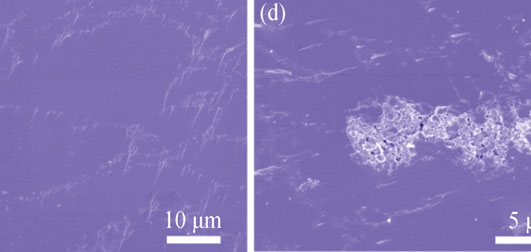
|
|
|
Structure and Property of Yb Doped Ca1-xRxF2+x (R=La, Gd) Laser Crystals
HE Yi-Feng, XUE Yan-Yan, LIU Wen-Qing, SU Liang-Bi, TANG Fei, WANG Jing-Ya
2017 Vol. 32 (8): 857–862
 Abstract
Abstract(
585 )
 HTML
HTML(
2)
 PDF
PDF(562KB)(
949
)
3at%Yb:Ca1-xRxF2+x (R=La, Gd; x=0, 0.01, 0.03, 0.06, 0.09) crystals were grown by a vertical Bridgman method. X-ray diffraction (XRD), Raman spectra, absorption spectra, fluorescence spectra and fluorescence lifetime were used to characterize the crystals. Effects of regulating ion La3+ and Gd3+ on lattice constants, Raman spectra and properties of Yb:CaF2 crystals were investigated. Moreover, the relationship between structure and spectral property of Yb3+ ion was analyzed and discussed. The results show that lattice constant and Raman FWHM gradually increase with the increase of La3+ or Gd3+ ion doping concentration, demonstrat that lattice expands and lattice vibration modes increases, respectively. Among 3at%Yb:Ca1-xLaxF2+x crystals, the crystal doped with 6at% La3+ has the largest absorption cross section (0.71×10-20 cm2) and the largest fluorescence intensity. Moreover, the crystal doped with 3at% Gd3+ has the largest fluorescence intensity. Increasing Gd3+ content up to 6at%, the crystal has the largest absorption cross section (0.64×10-20 cm2). These cooping crystals have better spectral parameters than 3at%Yb:CaF2 crystals. Based on the above results, structure of Yb3+ ion may be changed and the crystalline spectral properties may be optimized partly through the regulation of La3+ or Gd3+ ions’ concentration.
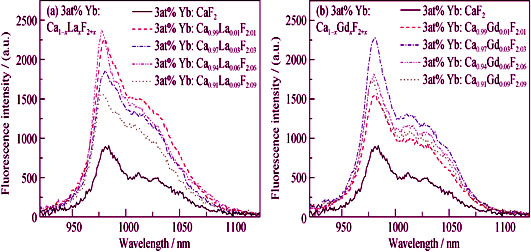
|
|
|
Synthesis and Photocatalysis Property of Ultra-small TiO2 Nanoclusters in Aqueous Media
LIN Jing-Cheng, TANG Xiao, CHU Wan-Yi
2017 Vol. 32 (8): 863–869
 Abstract
Abstract(
864 )
 HTML
HTML(
8)
 PDF
PDF(522KB)(
1184
)
Atomic clusters are of significant interest in catalysis. Ultra-small TiO2 nanoclusters, a stable Ti-O cluster with diameters of a few nanometers or less, can exhibit fascinating reactive, optical and electronic properties. In this work, ~2 nm TiO2 ultra-small nanoclusters were obtained by peptizing hydrolysate of tetrabutyl titanate (TPT) at 80℃. HRTEM and XRD were used to characterize microstructure of the ultra-small TiO2 nanoclusters, which was verified to have crystalline phase anatase. XPS demonstrated that the valence state of Ti atom was Ti4+ and no oxygen vacancy existed. Optical absorption properties were determined by UV-Vis spectroscopy and demonstrated that the ultra-small TiO2 nanoclusters had extraordinary strong absorption in the light wavelength range from 235 nm to 340 nm. According to the transmission spectrum, the optical band gap was calculated to be 3.56 eV, indicating an appreciable size-base quantum effect. The specific surface area was analyzed to be 269.28 m2/g for Langmuir surface area and 186.90 m2/g for multi-point BET surface area, respectively. Photocatalytic reduction of Cr6+ to Cr3+ in ultra-small TiO2 aqueous sol was investigated to estimate the photocatalytic activity. It demonstrated that the reduction rate of Cr6+ to Cr3+ by ultra-small TiO2 nanoclusters was four times faster than that by widely used nano-crystals one. And owing to extraordinary strong ultraviolet absorption of the former, Cr6+ was completely reduced to Cr3+ under sunlight illumination.
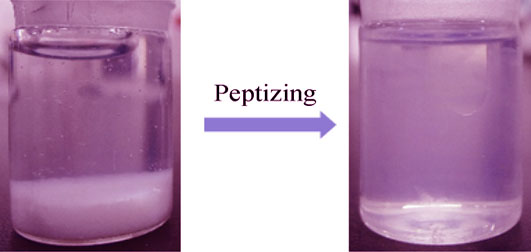
|
|
|
Improving Microstructure and Photoelectric Performance of the Perovskite Material via Mixed Solvents
GUO Xiu-Bin, YU Wei, Li Jing, JIANG Zhao-Yi, MA Deng-Hao, LIU Hai-Xu
2017 Vol. 32 (8): 870–876
 Abstract
Abstract(
748 )
 HTML
HTML(
12)
 PDF
PDF(533KB)(
1141
)
The perovskite (CH3NH3PbI3) thin films were prepared with pure N, N-dimethyl formamide (DMF), pure dimethyl sulfoxide (DMSO) and their mixtures with different volume ratios. The impact of different solvents on the microstructure and photoelectric properties of perovskite materials was systematically investigated. Results show that with the increase of DMSO in mixed solvents, the average grain size of CH3NH3PbI3 increases while the residual lead iodide (PbI2) decreases. Moreover, the ratio of ordered CH3NH3PbI3 crystals increases firstly and then decreases, and the highest ratio is achieved when the volume ratio of DMSO in mixed solvent is 60%. In addition, the relationship among Urbach energy characterization, time-resolved photoluminescence characterization and unreacted PbI2 residue indicates that the trace amounts of PbI2 may effectively passivate the defects in perovskite thin films, so as to prolong the carrier lifetime. The inverted planar heterojunction perovskite thin film solar cells were fabricated. The highest power conversion efficiency (PCE) of 15.1% (VOC=0.99 V; JSC=20.9 mA/cm2; FF=0.73) is achieved when the volume ratio of DMSO in mixed solvent is 30%. These results reveal that mixed solvents with appropriate volume ratio is favorable for the improvement of microstructure and photoelectric properties of perovskite materials.
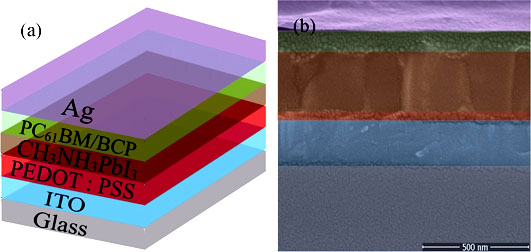
|
|
|
Anomalous Emission Performance of Eu3+-activated BiOCl Layered Phosphors Induced by Doping Zn2+
CHEN Fan-Li, LI Yong-Jin, ZHANG Xiang-Zhou, XU Zhu-Yuan, HU Rui, QIU Jian-Bei, YANG Zheng-Wen, SONG Zhi-Guo
2017 Vol. 32 (8): 877–883
 Abstract
Abstract(
646 )
 HTML
HTML(
2)
 PDF
PDF(537KB)(
899
)
Eu3+-activated BiOCl layered phosphors induced by doping Zn2+ were prepared by traditional solid reaction method, and the effect of Zn2+ ion dopants (0-20mol%) on the photoluminescence properties were characterized by X-ray powder diffraction (XRD), X-ray photoelectron spectroscopy (XPS), scanning electron microscopy (SEM), Fourier transform infrared absorption (FT-IR), excitation and emission spectra, and luminescence decay curves measurement. It is found that increase of concentration of Zn2+ ion dopants almost has no influence on the structure of BiOCl crystals but decreases the emission intensity of Eu3+ ion at first and then increases it, accompanying with continually enhancing luminescence lifetime of Eu3+ ions. The comparative experiments suggest that this results are involved in special layered structure of BiOCl semiconductor. Zn2+ ions would be incorporated into interlayer space of the BiOCl layered crystals when the concentration of Zn2+ ions ≤10%. Then, Zn2+ ions tend to incorporate into crystal lattices by substituting Bi3+ ions. Different doping mechanism of Zn2+ may change Eu3+ lifetime and modify energy transfer efficiency from the host, leading to above emission behavior of Eu3+ ion dopants. The result is helpful to improve performance of novel red Eu3+ doped BiOCl phosphor and to understand emission property of rare earth ion in layered phosphors.
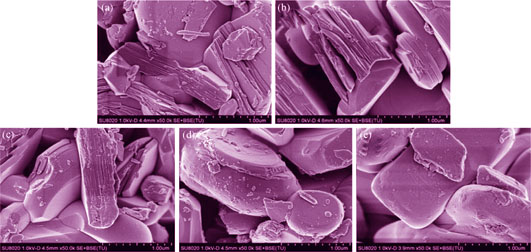
|
|
|
Synthesis and Rheological Property of Calcium Aluminate Cement Containing MgAl2O4 Spinel
FU Yun-Fei, ZHU Bo-Quan, LI Xiang-Cheng, CHEN Ping-An
2017 Vol. 32 (8): 884–890
 Abstract
Abstract(
744 )
 HTML
HTML(
7)
 PDF
PDF(521KB)(
983
)
Calcium aluminate cements with different MgAl2O4 spinel (CMA) contents and particle sizes were synthesized. The results revealed that when the synthesis temperature was raised from 1400℃ to 1500℃, the particle size of MgAl2O4 (MA) increased from 5 μm to 15 μm. The MA particles appeared in clusters and were distributed around the CaAl2O4/CaAl4O7 (CA/CA2) particles for CMA synthesized at 1400℃, while MA particles were inserted in the CA/CA2 particles for CMA synthesized at 1500℃. At the same time, the setting time lengthened and the viscosity decreased with the increase in MA content and particle size for CMA. The corresponding minimum values of storage modulus and flow point were 0.15 MPa and 4.44%, respectively. It is believed that the higher content of the MA phase and the larger particle size of CA/CA2 particles in CMA cement can result in a weak flocculation structure in hydrates.
|
|
|
Effects of TiC Content on Microstructure and Mechanical Property of WC-TiC-TaC Cemented Carbides
GAO Jiao-Jiao, JIANG Long-Kai, SONG Jin-Peng, LIANG Guo-Xing, AN Jing, XIE Jun-Cai, CAO Lei, LV Ming
2017 Vol. 32 (8): 891–896
 Abstract
Abstract(
891 )
 HTML
HTML(
12)
 PDF
PDF(435KB)(
1156
)
WC-TiC-TaC cemented carbides were fabricated by hot-pressed sintering at 1600℃. Effects of TiC content on the microstructure and mechanical properties of these cemented carbides were investigated. It was found that when TiC content was increased from 10wt% to 25wt%, both the average grain size and the Vickers hardness increased progressively, but both the flexural strength and the fracture toughness decreased gradually. The increase of Vickers hardness was attributed to the increase of TiC content and the hardness of TiC was higher than that of WC. The value of the highest Vickers hardness was 19.81 GPa. This work also showed that the highest flexural strength (1147.24 MPa) was ascribed to the fine and homogeneous grains, and that the highest fracture toughness (14.60 MPa·m1/2) was due to the intensive coupled mechanism of the fine-grain toughening, crack deflection, crack branching, crack bridging, and toughness dimples.
|
|